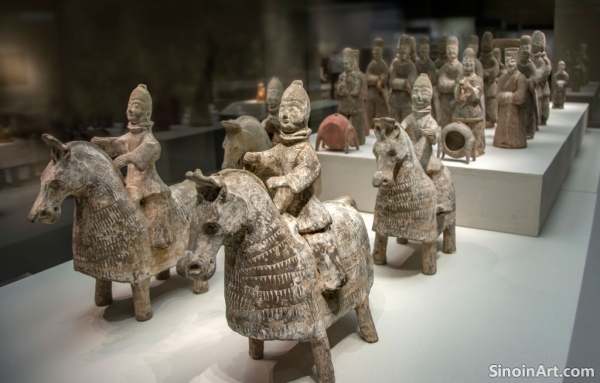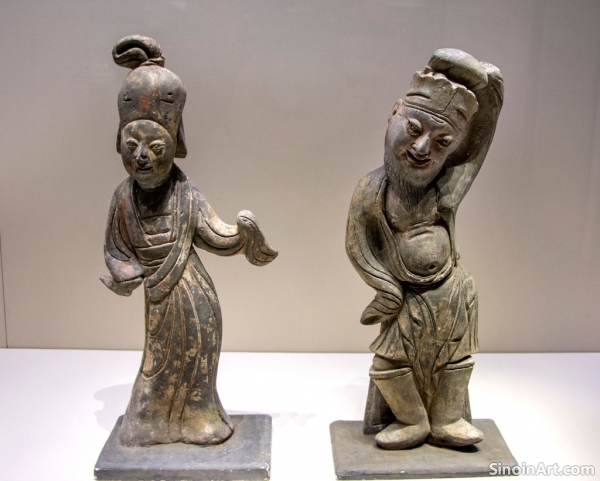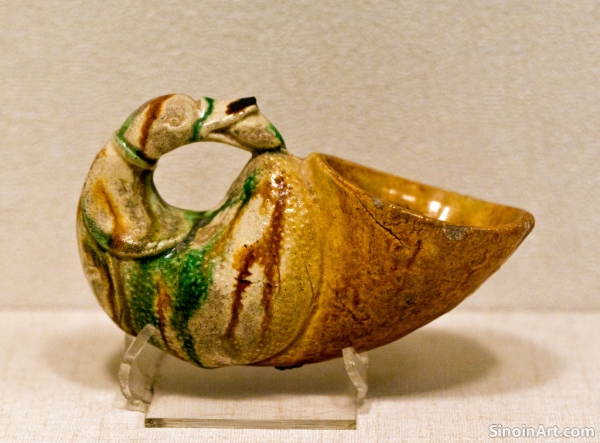Burial Goods and the Afterlife in Tang Ceramics
|
The Tang Dynasty saw the flourishing of an elaborate burial culture, with ceramics playing a central role in equipping the deceased for the afterlife. These funerary wares, from everyday objects to elaborate figurines, offer a fascinating glimpse into Tang beliefs about death, the spirit world, and the continuation of earthly life in another realm. These burial goods were not just functional; they were imbued with symbolic meaning and designed to ensure the comfort and prosperity of the deceased.  One of the most striking aspects of Tang burial ceramics is the variety and quantity of objects placed in tombs. From simple bowls and dishes intended for use in the afterlife to miniature models of houses, granaries, and even entire estates, Tang tombs were often filled with a vast array of ceramic goods. These objects reflected the status and wealth of the deceased and were meant to provide them with all the necessities they would need in their next life.  Figurines were another significant category of Tang burial ceramics. These figures, often made of sancai glazed earthenware, included depictions of court ladies, officials, soldiers, servants, and animals, particularly horses and camels. These figurines were not just static representations; they were often rendered with dynamic postures and expressive features, bringing the scene to life. The attention to detail in the clothing and accessories provided valuable insights into the daily life of the Tang Dynasty.  The inclusion of guardian figures in tombs further demonstrates Tang beliefs about the afterlife. These figures, often depicted as mythical beasts or fierce-looking warriors, were placed to protect the deceased from evil spirits. Their imposing presence highlights the belief that death was not the end but a transition to another existence that required protection and guidance. This emphasis on spiritual safeguards underlines the importance of funerary rituals in Tang society. The artistic quality and sheer abundance of Tang burial ceramics testify to the importance of these objects in funerary practices. They were not merely functional items; they were imbued with cultural and spiritual significance. These remarkable artifacts provide a valuable window into the beliefs, customs, and artistic achievements of the Tang Dynasty and underscore the vital role ceramics played in shaping their view of the afterlife. |
Tag : Tang Dynasty burial goods, Chinese funerary ceramics, tomb figurines, afterlife pottery, ancient Chinese tomb art
Related information
- Technological Advances in Tang Kilns
- Tang Ceramics and the Tea Ceremony
- The Influence of the Silk Road on Tang Ceramics
- Collecting and Appreciating Tang Ceramics Today
- Yue Ware Celadon: Subtle Elegance in Green
Tang Dynasty advancements in kiln technology, such as high-firing kilns and lead glaze control, enabled potters to produce a greater variety of higher-quality ceramics, significantly influencing later ceramic traditions.
While not as central as in later periods, the tea ceremony was beginning to gain popularity during the Tang Dynasty, and this had a subtle but significant impact on ceramic production. The growing appreciation for tea and the rituals surrounding its consumption influenced the development of specific ceramic forms and styles. The Tang tea culture, while not as formalized as in later dynasties, laid the groundwork for the widespread use of ceramics in tea service.
The Tang Dynasty was a period of unprecedented prosperity and cultural exchange, largely due to the flourishing of the Silk Road. This network of trade routes not only facilitated the exchange of goods but also ideas and artistic styles. The influence of the Silk Road on Tang ceramics is undeniable, introducing new techniques, materials, and decorative motifs that transformed the landscape of Chinese pottery. The interaction between different cultures created a vibrant and cosmopolitan atmosphere reflected in the artistic output of the time.
Tang Dynasty ceramics are highly valued by collectors and museums for their historical significance, artistic beauty, and technical innovation, requiring a detailed understanding for informed collecting and appreciation of these important cultural artifacts.
Yue ware, a Tang Dynasty celadon, is characterized by subtle green glazes, elegant forms, and fine, smooth bodies, reflecting a quieter aesthetic and influencing later celadon traditions across Asia.